![Broadway: John Street (1903) [This image is used with permission of Hicksville Public Library]](https://hicksvillehistoricalsociety.files.wordpress.com/2016/01/broadway.jpg?w=413&h=274)
To most Long Island residents, Hicksville is a major transportation hub and home to the only IKEA outlet store east of New York City. Undoubtedly, most residents know little of Hicksville’s humble beginnings as a farming community and its evolution into a prominent business area in the early twentieth century. Subsequently, the population expansion of Nassau County in the post-World War II years changed Hicksville. To allow for better movement of vehicular traffic, the railroad tracks were elevated and some major roads were widened. Although the action altered the layout of the community and eliminated a chunk of the business district, it was considered dire because Hicksville’s grade-level station was at the crossroads of the Long Island Rail Road’s (LIRR) Main Line and Port Jefferson Branch. When a train passed through, traffic backed up for over a half-mile. It can be argued that progress raped Hicksville of its businesses and small village-like identity. While current Hicksville is an ideal location to raise a family in a suburban setting similar to neighboring Levittown, there is no downtown Main Street location similar to other Nassau communities. Much has been done over the years to revitalize the downtown area and give it a sense of Main Street character. The following is a short history of Hicksville and how it evolved into a large Long Island suburb with a struggling downtown section.
Beginnings and Arrival of the Railroad
![Elias and Valentine Hicks [This image is used with permission of Hicksville Public Library]](https://hicksvillehistoricalsociety.files.wordpress.com/2016/01/elias_and_valentine_hicks.jpg?w=415&h=287)
The modern-day hamlet of Hicksville in the town of Oyster Bay in Nassau County, New York was originally part of the 5,000 acres that Robert Williams of Hempstead purchased in 1648 from Pugmpan, a chief of the Matinecock Indian tribe. The property was the eastern portion of the Hempstead Plains featuring miles of prairie grass. While some land was used for grazing, what is now Hicksville, lay vacant for nearly two centuries. It was not until a Jericho businessman named Valentine Hicks, son-in-law of the nationally-famous preacher Elias Hicks, set out to develop it. Hicks formed a land association in 1834 to create a community on the plains.[1]
![Steam Train [This image is used with permission of Hicksville Public Library]](https://hicksvillehistoricalsociety.files.wordpress.com/2016/01/steam_train.jpg?w=408&h=284)
Since the new community named after Hicks was “in the middle of nowhere” there was no easy way to get to it. Railroading at the time was restricted to the island’s western portion. No doubt, Hicks was influential in the arrival of the LIRR in 1837 since he was a member of the railroad’s board of directors and later its second president. The Hicksville station stop first opened on March 1, 1837. As a state-chartered railroad, the LIRR’s purpose was to be a link in an all-rail route to Boston. When completed in 1844 the LIRR ran across the center of Long Island to Greenport where passengers were ferried to Stonington, Connecticut and then connected with a train to Boston. However, a competing railroad built along the rocky Connecticut shore, first deemed impossible, made the LIRR route to Boston obsolete in 1850. In lieu, the Long Island sought to serve local ridership to points east and west.[2]
![First School House in Hicksville (1853) [This image is used with permission of Hicksville Public Library]](https://hicksvillehistoricalsociety.files.wordpress.com/2016/01/first_school_house_in_hicksville.jpg?w=390&h=294)
One of the first ethic groups to dominate Hicksville was German. In 1849, two German-American land speculators, Frederick Heyne and John Heitz, acquired land and laid out lots. In an attempt to embrace Hicks’s unrealized dream of a town, Heyne and Heitz advertised the community in New York City to German immigrant families. Within a few years Hicksville was transformed into a prosperous German-American village. Additionally, the land outside of the
![Broadway Facing North from Augustin Mansion (1900s) [This image is used with permission of Hicksville Public Library]](https://hicksvillehistoricalsociety.files.wordpress.com/2016/01/broadway_facing_north_from_augustin_mansion.jpg?w=357&h=336)
village, which was long considered of little value for agriculture, developed into productive vegetable farms.[3] Not only was the prairie land ideal for farming but the freight house at Hicksville Station could ship goods to Brooklyn and beyond. In no time, a village was established around the station while farming was restricted primarily to the south of the railroad’s right-of-way along the major thoroughfares of Broadway and Jerusalem Avenue, as well as Old Country Road. In fact, the German population was so strong that the first newspaper, the Long Island Central Zeitung in 1873, was printed in German.[4]
John Heitz later devoted much of his life to the development of Hicksville. He donated property for a public school, planted trees and laid out sidewalks, and founded a cemetery. Upon his death, Heitz was the largest landowner in the area. Another early businessman was Frederick Herzog who arrived in 1863 and opened a grocery business.[5]
![Episcopal Church (1927) [This image is used with permission of Hicksville Public Library]](https://hicksvillehistoricalsociety.files.wordpress.com/2016/01/episcopal_church.jpg?w=393&h=399)
Hicksville was the most diverse of the German settlements on Long Island. Covering an area of about six-and-one-half miles, it was part village, part agricultural settlement, with a variety of ethnic churches, clubs, gathering places, and institutions.[6] Small-scale craft industries included gold-beating workshops. On the other hand, the agricultural industry grew into extensive market gardens and vegetable farms. By the late nineteenth century, Hicksville’s hotels attracted German-American vacationers from New York City. One was called the Grand Central Hotel that boasted a picnic area, dancing pavilion, bowling alley, and a hall that held over 600 people.[7]
![Grand Central Hotel (1800s) [This image is used with permission of Hicksville Public Library]](https://hicksvillehistoricalsociety.files.wordpress.com/2016/01/grand_central_hotel.jpg?w=736&h=515)
Community on the Plains Becomes a Central Business District
![Broadway, looking south: Bank of Hicksville (left) (1920s) [This image is used with permission of Hicksville Public Library]](https://hicksvillehistoricalsociety.files.wordpress.com/2016/01/broadway_looking_south.jpg?w=445&h=295)
In the early twentieth century, Hicksville became an established business leader in Nassau County. Many merchants operated within a downtown district established south of the grade-level railroad crossings at Broadway and Jerusalem Avenue. Herzog Place and Marie Street also featured many stores and shops. By the outbreak of World War II, there was intense competition between the Hicksville merchant and Hempstead retailer for weekend trade. In addition to local merchants, there were several pickle-works companies built in the 1890s including the H.J. Heinz Co., which shipped to other areas of the island from a railroad siding.[8]
![Fire Department Company 5: Current Peppercorn's Restaurant building (1927) [This image is used with permission of Hicksville Public Library]](https://hicksvillehistoricalsociety.files.wordpress.com/2016/01/fire_department_company_5.jpg?w=391&h=321)
Downtown growth necessitated a reliable fire department. The first volunteer group was organized in 1868 as one company. In 1893 a total of three companies were united as the Hicksville Volunteer Fire Department with Arnold G. Heitz elected first chief. A little over a decade later the first firehouse opened with widespread celebration on May 30, 1906. Today, this is the two-story building known as Peppercorns Restaurant, although several modifications have been made. It was moved from the north side of Marie Street to the south to accommodate the current brick fire house.[9]
![Court House: Current home of the Gregory Museum (1895) [This image is used with permission of Hicksville Public Library]](https://hicksvillehistoricalsociety.files.wordpress.com/2016/01/court_house.jpg?w=273&h=396)
Another old Hicksville building still standing today is the Heitz Place Courthouse, home to the Hicksville Gregory Museum. Completed when Nassau County was part of Queens County, the building was constructed in 1895 as a village hall on land donated by Arnold Heitz. Between 1895 and 1920 it served a variety of governmental and meeting purposes. Justices of the peace, who were also town councilmen, held court once a week. Assistants were elected as part-time constables and caretakers of the jail on the building’s north side. By 1915 the existing jail was deemed inadequate and a brick three-cell jail was built adjacent to the building. One of these cells was retained by the museum.[10]
The Heitz Place Courthouse served as headquarters for Selective Service for eastern Nassau County during both world wars. By the late-1950s, Nassau County District Court’s jurisdiction changed and cases at Heitz Place were limited to those of non-jury disposition. The building remained active as a court until 1967 when the county closed its Fourth District Court in Hicksville and moved to new quarters. It unfortunately was vandalized until 1970 when arrangements were made for a long term lease to serve as a Long Island earth science museum. The United States Department of the Interior recognized the building as a National Historic Place on July 30, 1974.[11]
Hicksville Gardens
Some prominent leaders in the early twentieth century attempted to zone an area of eastern Hicksville for estates. The community was referred to as Hicksville Gardens and early homeowners were distinguished Nassau County residents who selected Hicksville as an ideal location to build large homes. A few of these men went on to transform Hicksville into the modern suburb it is today. In fact, influential residents twice tried to change Hicksville’s name because they felt it made a poor impression. The first time was in 1893 when Waldorf was suggested. The second was in 1923 when Quentin was proposed. Quentin was President Theodore Roosevelt’s pilot son who was killed in the First World War. However, the plurality of residents voted to retain Hicksville.[12]
![South Broadway (Early 1900s) [This image is used with permission of Hicksville Public Library]](https://hicksvillehistoricalsociety.files.wordpress.com/2016/01/south_broadway1.jpg?w=385&h=258)
Hicksville Gardens was established long before post-World War II expansion. After electric rail service was available to Penn Station in 1910 a building boom was expected on Long Island. It would wait until the 1920s when Central Long Island began feeling suburban expansion especially along the railroad’s Main Line. In May of 1925, William Kennedy sold at auction an “unusually well located track of residential land” in the thriving town of Hicksville. Property was offered to the highest bidder and comprised 177 lots. By this time the area was the center of considerable home building. Advertisements stressed the excellent roads, water and electric power, and the news that the LIRR planned to electrify rails to Hicksville by July 1926. However, electric service was almost fifty years away.[13]
![St. Ignatius Church and Rectory (Early 1900s) [This image is used with permission of Hicksville Public Library]](https://hicksvillehistoricalsociety.files.wordpress.com/2016/01/st_ignatius_church_and_rectory.jpg?w=410&h=290)
Henry G. Eisemann and his brother Phillip Eisemann had homes constructed in the Gardens.[14] Henry was a leading Nassau County citizen who lived on Field Avenue. He served in the First World War as a Marine and later became an insurance broker with Seaman, Taliaferro & Eisemann, Inc. Among the many positions that he held were president of the Bank of Hicksville and Chairman of the Oyster Bay Town Republican Committee. He also was on the board of directors of the Hicksville Chamber of Commerce, the Long Island Association, and the New York Good Roads Association. In 1946, Eisemann was on the War Memorial Committee to develop a memorial mall on the grounds of Hicksville High School for those who served in the armed forces. He was also a part of the Citizens’ Zoning Committee seeking rules for home developments in restricted estate sections throughout the town of Oyster Bay. This committee was later assisted by John A. Muddeman and Associates, a firm of zoning and planning experts hired by the town.[15]
![Railroad in Hicksville: Steam engine on eastbound platform and freight house [This image is used with permission of Hicksville Public Library]](https://hicksvillehistoricalsociety.files.wordpress.com/2016/01/railroad_in_hicksville.jpg?w=461&h=189)
Other residents of the Gardens included Alfred C. Shaknis and Ernest F. Franke. Shaknis was an architect from Glen Head. Some his work includes the Georgian-style red-brick First National Bank of Glen Cove where he later served on the board of directors, the C.W. Post College and Southampton College buildings of Long Island University, the Our Savior’s Lutheran Church of Glen Head, and the Old Brookville Police Department headquarters on State Route 25A. He was friend and architect of Henry Eisemann and designed his kitchen. Franke was a telephone company repair foreman and later County Clerk. Like Eisemann, he also served on the Hicksville Chamber of Commerce.[16]
![Julius Augustin Mansion: Current site of Delco Plaza [This image is used with permission of Hicksville Public Library]](https://hicksvillehistoricalsociety.files.wordpress.com/2016/01/julius_augustin_mansion.jpg?w=386&h=257)
Men like Eisemann and Franke wanted to protect the quaint area of the Gardens, organizing a zoning committee to see that property was protected. At the same time they realized the necessity of building modern Hicksville to handle vehicular traffic while maintaining a downtown business district. In the 1950s when a train passed through, Broadway traffic was typically backed up in both directions at all railroad grade crossings. Community leaders realized something needed to change. Both Eisemann and Franke were members of the Chamber of Commerce in the 1950s during discussion of both the elevation of the railroad tracks and the widening of Broadway. Sadly, Eisemann died following the erection of the new station and before the widening of Broadway.[17]
Hicksville after World War II
The postwar boom transformed Hicksville into a bustling suburb by 1959, with a population increase from 8,000 to near 50,000. The former pickle business ended before the First World War because cucumber plants died after a blight. Farmers turned to potatoes that also died from a blight in the 1940s. These potato farms were later converted to new housing developments.[18]
![Broadway: nighttime vista (1950s) [This image is used with permission of Hicksville Public Library]](https://hicksvillehistoricalsociety.files.wordpress.com/2016/01/broadway-1.jpg?w=736&h=502)
Nevertheless, downtown Hicksville remained a small center for merchants, the railroad, and religious institutions. Broadway was the center of the village, with stores on both sides. Newbridge Road and its tree-lined center island joined Hempstead Turnpike and the heart of Hicksville at Herzog Place. At this time, Newbridge Road did not cross north of the tracks. Other streets also canopied with trees were Marie Street, Plainview Road, Jerusalem Avenue, and Woodbury Road.[19] On the west side of Broadway was an ice cream parlor and delicatessen, Chroma Paint, Dwyer’s Tavern, and the neo-classical Long Island National Bank building at Herzog Place. On the east side was the one-time Bank of Hicksville building which was taken over by the town of Oyster Bay in 1959 as a town hall annex. Between Marie and Nicholai Street, the old stores and Church of Christ were on the site of the village’s earliest church. St. Ignatius-Loyola Church, which was built in 1891 and still stands today, is on the corner of Nicholai Street and at the time featured the colors of brown and buff. Another early religious center was the Albin House with masses celebrated by priests who came from Jamaica. Nick’s Rainbow Bar to the south was a local watering hole that once housed the post office. [20]
At the northwest corner of Broadway and Marie Street was the Freytag Building. It housed Englert’s Bake Shop (the former Bahrenburg’s), the Sweet Shop, the Rogers five and dime store, and the Seaman & Eisemann insurance office headed by Henry Eisemann. Modern-day Delco Plaza was a large, landscaped tract of land that featured the mansion of Julius and Louise Freytag Augustin. Augustin was an enterprising German immigrant who became a respected merchant and Oyster Bay Justice of the Peace.[21]
Changes that Altered Hicksville: Railroad Grade Crossing Elimination
In the 1960s, two events altered Hicksville: the elevation of the railroad tracks and the widening of both Broadway and Newbridge Road.[22] The idea to eliminate all nine railroad grade crossings in the area arose as early as the 1930s when there were complaints that fire equipment was delayed when a train passed through.[23] In fact, in 1939 the Nassau County Board of Supervisors recommended six Hicksville crossings be eliminated by the state.[24] After World War II, the prosperous economy heightened Broadway’s business activity. When a train passed Hicksville, the vehicular traffic backed up to Nicholai Street. Fatalities at the crossings were also not uncommon. Between 1949 and 1954, there were fifty-two accidents with four motorists killed and sixteen injured.[25]
![Broadway: grade crossing; view northwest (March 1942) [This image is used with permission of Hicksville Public Library]](https://hicksvillehistoricalsociety.files.wordpress.com/2016/01/broadway-3.jpg?w=383&h=257)
No doubt, both two-lane roads and railroad grade crossings created lots of traffic, aggravating both motorists and merchants. The opening of Mid-Island Shopping Plaza at the former St. John’s Protectory for Boys in 1956, later named Broadway Mall, only brought more cars.[26] In July of 1955, the town of Oyster Bay issued a traffic report which cited that the lack of commuter parking, rather than shopper parking, was the major traffic problem. It proposed new parking fields off Duffy Avenue to take commuter parking off the streets. At the time, Hicksville had six municipal parking fields with capacity for 579 cars.[27]
![Broadway West Across Jerusalem Avenue: LIRR right-of-way and Jerusalem Avenue crossing with Hicksville Station depot building and freight house (far right); track view west (March 13, 1942) [This image is used with permission of Hicksville Public Library]](https://hicksvillehistoricalsociety.files.wordpress.com/2016/01/broadway_west_across_jerusalem_avenue.jpg?w=371&h=291)
In truth, the parking solution would eventually come too late. The primary focus was elimination of grade crossings.[28] In 1950 the Hicksville Civic and Community Association began a letter writing campaign requesting state officials take action. However, it was not until four years later that the elevation project became serious, thanks to the efforts of State Assemblyman John J. Burns. In August 1954 the Public Service Commission (PSC) held a hearing on the matter in New York City. Three engineering possibilities were made public: elevation of the tracks above street-level, depression of the tracks below street-level, or a combination of the two. By January of the following year, the commission reduced the options to two since track depression cost double. Tracks could be raised on an embankment, or solid wall of masonry and earth, or elevated on an open trestle or pillars.[29]
![Railroad Station: LIRR Hicksville Station depot building and westbound platform (eastbound platform is in the foreground); track-side view northeast (1950s) [This image is used with permission of Hicksville Public Library]](https://hicksvillehistoricalsociety.files.wordpress.com/2016/01/railroad_station.jpg?w=433&h=288)
In early discussions, there were some that opposed elevated tracks. One critic was Mid-Island Times newspaper editor Fred Noeth who asserted that not enough general public and leadership thought was given to the type of grade elimination that best fit Hicksville. County Clerk Franke chimed in stating that residents and community leaders needed to go before the PSC united on the project or it would be delayed.[30]
The year 1955 was a turning point for Hicksville’s future. A June announcement from the PSC ordered seven crossings in Hicksville “designated for elimination,” with cost estimated at $9,558,000. The commission submitted that congestion along Hicksville’s major roads was caused by the ninety trains per day that passed through, creating traffic delays for over eight hours in a sixteen-hour time period. It would not be until 1958 that the PSC approved the architectural and planning costs which included moving the station freight house to the Charlotte Avenue crossing. Relocation facilitated grade elimination and enabled the town to develop some commuter parking facilities at the existing freight house and team track area.[31]
![Train Station: LIRR Hicksville Station depot building and westbound platform (Early 1960) [This image is used with permission of Hicksville Public Library]](https://hicksvillehistoricalsociety.files.wordpress.com/2016/01/train_station3.jpg?w=406&h=276)
The Hicksville Chamber of Commerce was a proponent of track elevation as early as 1955. To expedite progress, it launched a petition. A committee was organized, headed by Aaron Rochman.[32] By September 1959 there were 16,000 signatures requesting the state take action. Upon receipt, State Governor Nelson Rockefeller added that he would send the support of his office to assure early completion of the project.[33]
![Train Elevation: Photograph showing temporary Broadway grade crossing and viaduct construction as well as Long Island National Bank building at Herzog Place (Early 1960s) [This image is used with permission of Hicksville Public Library]](https://hicksvillehistoricalsociety.files.wordpress.com/2016/01/train_elevation.jpg?w=404&h=280)
By the spring of 1960 a total of $896,000 was already spent moving the freight station. In October of 1961, Hendrickson Bros. Inc. of Valley Stream won the track elevation job bid, at a cost of $8,760,040.50. Work was scheduled for completion by July 1, 1964. However, work was extended to the fall and the job was officially completed on September 10 after the final use of temporary grade-level tracks. Thereafter, all traffic used the new elevated section. Overall, the project covered three miles, involved eleven miles of track, and eliminated five grade crossings on the Main Line and two on the Port Jefferson Branch. It also relocated and extended Newbridge Road under the viaduct.[34]
![First Train on Elevation Section: Track elevation completion ceremony (September 10, 1964) [This image is used with permission of Hicksville Public Library]](https://hicksvillehistoricalsociety.files.wordpress.com/2016/01/first_train_on_elevation_section.jpg?w=410&h=279)
On hand at a small completion ceremony were such men as Assemblyman John J. Burns, County Executive Eugene Nickerson, LIRR President Thomas Goodfellow, and Aaron Richman. The Hicksville High School band played music and hundreds of residents were on hand, with three ladies dressed in mid-nineteenth century costumes to symbolize the 1837 arrival of the first LIRR train.[35]
Two notable buildings were eliminated due in the project. First, a frame building on the east side of Broadway that housed an electrical equipment company was torn down. It was the last remaining structure of the Grand Central Hotel built in 1835.[36] Secondly, the former 1909 railroad depot building was torn down on November 30, 1962. A LIRR publication handed to passengers the morning of the demolition warned “this morning you see it …this evening you won’t.”[37]
![Broadway Looking North: LIRR viaduct over Broadway (1964)[This image is used with permission of Hicksville Public Library]](https://hicksvillehistoricalsociety.files.wordpress.com/2016/01/broadway_looking_north.jpg?w=406&h=260)
While track elevation alleviated some traffic, the aftershocks of the project would be seen for decades. Foreshadowing the impact of track elevation, Fred Noeth in a March 1960 editorial cited that Hicksville would be faced with changes resulting from a “Chinese Wall” that divided the community in three segments.[38] Prior to the completion of the project, Noeth also wrote in a Christmas Eve 1963 editorial that change would be seen in two places: first in the local economy and second in the direction of town government.[39] Indeed, the community was divided into segments and the economy was affected since the project led to the widening of Broadway. Many stores were torn down in order to make way for a widened road.
![Eagle Dedication (May 15, 1965) [This image is used with permission of Hicksville Public Library]](https://hicksvillehistoricalsociety.files.wordpress.com/2016/01/eagle_dedication.jpg?w=736&h=521)
![Penn Eagle: LIRR Hicksville Station central building, Goldberg Eagle, viaduct and platforms; view southeast (1966) [This image is used with permission of Hicksville Public Library]](https://hicksvillehistoricalsociety.files.wordpress.com/2016/01/penn_eagle.jpg?w=736&h=482)
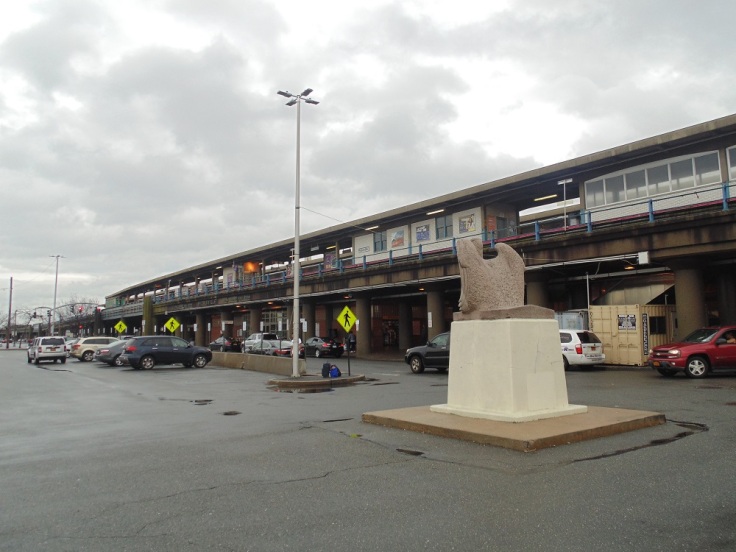
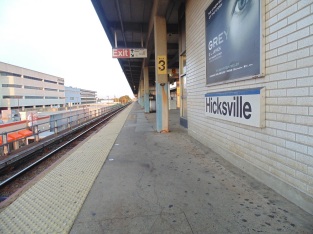
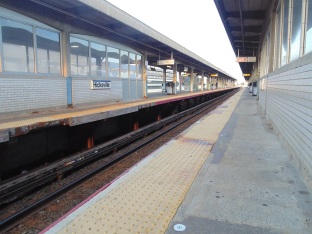

Changes that Altered Hicksville: Widening of Broadway and Newbridge Road
Even though the July 1955 traffic study reported that the lack of commuter parking space was Hicksville’s traffic problem, the State Department of Public Works (DPW), without formal
![Train Station: LIRR Hicksville Station north and south platforms (left to right) on embankment west of the viaduct; track-side view east (1970) [This image is used with permission of Hicksville Public Library]](https://hicksvillehistoricalsociety.files.wordpress.com/2016/01/train_station2.jpg?w=300&h=203)
announcement, decided that Broadway must be widened from two to four lanes to expedite vehicular traffic through Hicksville. Broadway landlords were informed in September 1957 that a $2,000,000 public acquisition program would demolish buildings in the triangle between Broadway and Jerusalem Avenue, as far north as John Street, to permit the widening of Broadway.[40]
Four years of rumors persisted. Some feared the worst especially since the widening of Broadway from the railroad crossing north to Jericho Turnpike was proceeding ahead of schedule. It was completed in September 1959, tripling the road’s width.[41] However, editor Noeth assured residents in July of 1962 that the state planned to abandon widening south of the tracks through downtown Hicksville. According to his sources, construction of the Seaford-Oyster Bay Expressway would absorb north to south traffic.[42]
![Widening of Broadway (1967) [This image is used with permission of Hicksville Public Library]](https://hicksvillehistoricalsociety.files.wordpress.com/2016/01/widening_of_broadway.jpg?w=364&h=240)
The year 1963 was the turning point. Condemnation of Property notices were published in the official legal notice section of local papers in April. Rumors also spread based on the word of property owners south of Old Country Road who claimed that the state planned to acquire property setbacks. The most noticeable indication that Broadway would be widened was the design of the viaduct. The west side support columns encroached on the roadbed, signaling that it would be the center of a larger road.[43]
![View of South Broadway from Professional Building (1970s) [This image is used with permission of Hicksville Public Library]](https://hicksvillehistoricalsociety.files.wordpress.com/2016/01/view_of_south_broadway_from_professional_building.jpg?w=390&h=265)
For months the Chamber of Commerce prodded the DPW for information. However, it was not until the week of October 24, 1963 that the DPW spelled out in considerable detail the plans for Hicksville. From the LIRR south to Old Country Road, a total of forty-four feet would be removed from the west side of Broadway. Although the Chamber of Commerce pointed out that it was never asked to take a position in the project, the DPW forged on. There was little doubt that Broadway would be widened from sixty-eight feet to one-hundred-ten feet, including a paved twenty-foot center mall.[44]
![Broadway Looking North: East Marie Street to LIRR viaduct (1984) [This image is used with permission of Hicksville Public Library]](https://hicksvillehistoricalsociety.files.wordpress.com/2016/01/broadway_looking_north-1.jpg?w=382&h=260)
The Main Street character of downtown Hicksville was about to change. Broadway came under state jurisdiction in 1924 and subsequently widened. Now it would be widened even more. What was once an eighteen-foot wide county road would be a major north-to-south state highway. In 1964, the Chamber of Commerce was notified that Newbridge Road would also be widened from the railroad to Old Country Road, construction to begin in 1966. The road would extend under the viaduct on what was Jackson Place to Broadway.[45] In the meantime the demolition of buildings on the west side of Broadway began in July of 1967.[46]
In the end, Broadway was widened and the row of stores and building on its west side were demolished. In 1960 the New York Times predicted that state highway expansion meant the end of Hicksville as a major center to thriving independent stores and businesses. It was instead systematically converted into “a formless glob of many residents with no core, future or ambitions.”[47] Indeed, a Mid-Island Herald article on August 5, 1965 pointed out that while there were now more retail outlets in the community than before, they were no longer grouped within the four-block area south of the LIRR along Broadway, Jerusalem Avenue, and Marie Street. Historian Richard Evers argued, albeit correctly, the old-time downtown shopping district with Friday and Saturday night crowds was gone[48] and there was a sense of Hicksville “being adrift without a rudder.”[49] In the “rape of Hicksville,” the state by its arbitrary power destroyed the well-known and familiar Hicksville Main Street from John Street to Old Country Road.[50] Years later, an editorial in the Mid-Island Times commented that following construction, Hicksville looked like ancient Troy after the Greeks destroyed it.[51]
G-I Zoning
![Broadway: aerial view at John Street; view northwest (1960s) [This image is used with permission of Hicksville Public Library]](https://hicksvillehistoricalsociety.files.wordpress.com/2016/01/broadway-4.jpg?w=404&h=269)
While it seemed like Hicksville’s days as a business leader were over, both commercial and industrial businesses opened in Hicksville after 1966. In fact, Hicksville ranked third in the entire county with 682 businesses in 1967. But, the quaint little village was no more. To some, the St. Ignatius-Loyola Church steeple was the only familiar landmark remaining.[52]
One of the first plans to redevelop downtown Hicksville was proposed by architect Larry Scalera. It featured a shopping center west of Broadway and south of Marie Street with three or more underground parking levels. A Chamber of Commerce committee was set up to hear the plan and seek federal funding as part of an urban renewal program. The project however never came to fruition.[53]
![St. Ignatius Church: Broadway [This image is used with permission of Hicksville Public Library]](https://hicksvillehistoricalsociety.files.wordpress.com/2016/01/st_ignatius_church.jpg?w=290&h=420)
Another idea much to the dismay of residents was downtown Hicksville as a transportation hub. It was first proposed by the Nassau County Planning Commission to obtain state funds for a transit center with multiple parking lots since existing lots for rail commuters was inadequate or inconvenient. Subsequently, the Metropolitan Transportation Authority (MTA), the LIRR’s state-operated parent company, designated Hicksville as a “transportation center” for rail, bus, and cars.[54] In response, the town of Oyster Bay Planning Advisory Board called for office and new residential development in what was termed the Triangular Plan. It was suggested that office structures could be built up to eight stories. In order to accomplish this, existing zoning laws needed to be changed.[55]
Many residents opposed the plan stating that “this [was] suburbia not the city.”[56] Nevertheless, in the summer of 1971 the town established the “G-I” central business zone in Hicksville, replacing the former neighborhood business “F” and general business “G” zone, that would permit five-story buildings. However, the town scraped plans for apartments. Effective in 1971, the G-I zone encouraged the use of public transportation to reduce congestion.[57]
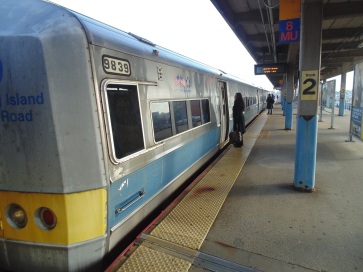
Since that time there have been some office buildings constructed but far from what was originally envisioned. To aid commuter parking, a town-operated commuter parking garage was built at the corner of Newbridge Road and Duffy Avenue adjacent to the railroad station. Construction started on May 4, 1971 and was completed in February of 1972 at a cost of $3,900,000. Consulting engineers for the project were Sidney B. Bowne & Sons. The new three-tiered structure was designed to be readily expandable.[58] Indeed, additional commuter was needed as rail service to Hicksville was electrified in October of 1970, the railroad’s first new electrification since 1925, allowing for a one-seat ride to Manhattan in new “Metropolitan” cars.[59]
Revitalization
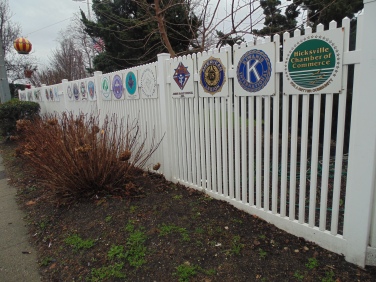
In the second-half of the twentieth century, Hicksville’s potato fields were converted for home development. By 2000 there were over 13,000 houses, and the 230,000-square-foot IKEA home furnishing outlet and the 180,000-square-foot Sears store. The New York Times noted that if Hicksville had an Indian name it could be “place of many houses and big stores,” in tribute to the many Cape Cod, split-level, and ranch homes as well as the two retail giants. For recreation, in addition to some small town-owned playgrounds and parks, there is the 116-acre Cantiague Park featuring a golf course, indoor ice rink, and outdoor swimming pool. While there is no downtown area remotely similar to yesteryear, the heart of the community lies in the many community and civic organizations. They have maintained a sense of identity for the present and hopefully the future, and attempted to revitalize Hicksville.[60]
![Fountain: Kiwanus Club Memorial Fountain at Kennedy Park [This image is used with permission of Hicksville Public Library]](https://hicksvillehistoricalsociety.files.wordpress.com/2016/01/fountain.jpg?w=234&h=356)
In the first two decades after G-I zoning was in effect, there were a few endeavors to better downtown Hicksville and make it more attractive. Initially, the Chamber of Commerce Beautification Committee strove to make Broadway more presentable, both north and south of the railroad, by planting flowers in the center median.[61] In 1979 the Kiwanus Club dedicated a memorial fountain, north of tracks at the junction of Broadway and Jerusalem Avenue in present-day Kennedy Park.[62] Aside from other small civic projects, there were no major developments within downtown Hicksville except for the construction of the Greenpoint Savings Bank in 1987 on the northwest corner of Broadway and Old Country Road.[63] Most of the west side of Broadway remained vacant.
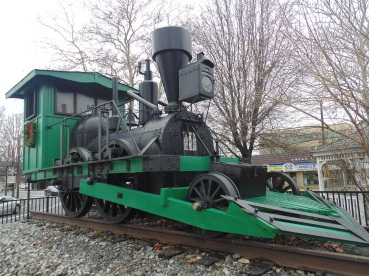
Revitalization of Hicksville kicked in when the community celebrated the 350th anniversary of the Robert Williams purchase. A four-day weekend of activities in September 1998 included a parade where over sixty-five organizations commemorated Hicksville’s historic heritage and thousands lined the parade route to cheer and revel in history. The parade began in front of the MarketSpan building on Old Country Road, traveled through downtown to the Broadway Mall where congratulations and commendations were given at a reviewing stand. Groups included the middle school and high school bands, various Boy Scout and Girl Scout Troops, Hicksville American Soccer, Hicksville Hockey, Tiger Schulmann’s Karate, SADD, and the Hicksville Youth Council. Other weekend events and activities comprised a fireworks display and two free concerts.[64] Other anniversary events in the year included “Open House Afternoons” at Hicksville churches and synagogues[65] and a fall festival in October.[66]
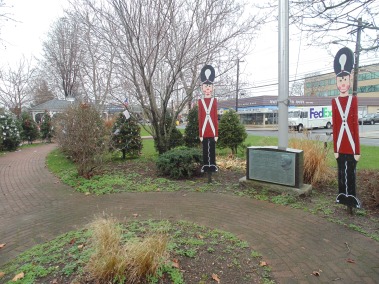
The anniversary gave Hicksville residents a renewed sense of pride, bolstered by celebrating what was, seeing what is, and visualizing what could be. In a sense, it prompted what the Hicksville Illustrated News referred to as a movement to “re-create the Hicksville community.” First, “Project Downtown,” sponsored by the Chamber of Commerce, aimed to revitalize downtown Hicksville. Secondly, various civic organizations took it upon themselves to beautify the community. Finally, town, county, and state government intensified efforts to aid Hicksville endeavors. As a matter of fact, the movement was ignited by a survey conducted in late 1997 and early 1998 that focused on many neglected areas of Hicksville. In its final report, Project for Public Spaces, the firm hired to conduct the survey, stressed the undesirability of certain public areas such as Kennedy Park and the underutilization of the LIRR station. Cynthia Abramson, Project for Public Spaces’ project manager for Hicksville, stated that Kennedy Park had enormous amount of potential as a community center.[67]
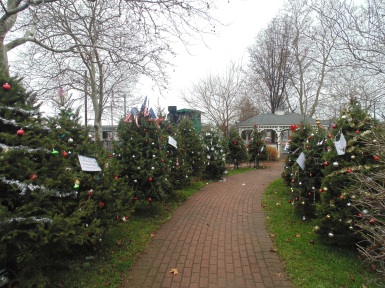
While work was planned for Kennedy Park, civic organizations began other projects. The Northwest Civic Association’s Beautification Committee adopted two areas in a clean-up and maintenance effort that produced over 800 pounds of garbage in a few short months. Going one step further, the Duffy Park Civic Association deemed October 1998 as “Beautiful Hicksville” month, cleaning up three separate spots on Duffy Avenue. Multiple levels of government also joined the effort. The county planted new trees on Jerusalem Avenue and redesigned the intersection at West John Street and Cantiague Rock Road. One local politician who was instrumental in obtaining a grant for downtown revitalization was State Assemblyman Marc Herbst.[68]

As the acknowledged community center, a “Gateway to Hicksville” sign was installed at Kennedy Park on Thanksgiving weekend in 1998. Purchased by the Hicksville Chamber of Commerce, it was placed on the east side of the Kiwanis Memorial Fountain and dedicated to the town of Oyster Bay in honor of a donation from Geral Associated. On hand for the event were Assemblyman Herbst, Oyster Bay Councilman Thomas Clark, John Geral, Hicksville Chamber of Commerce President Patricia Conway, and Oyster Bay Supervisor John Venditto.[69]
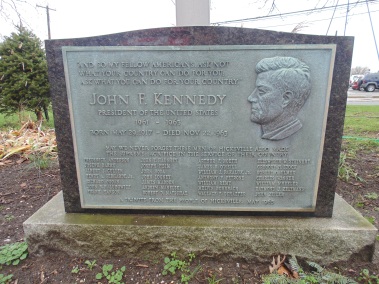
Beautifying the park continued into the new millennium as revitalization plans included replacing the sign that displayed logos for local civic groups and other organizations with an eighteen-by-eighteen foot board. Other work included the installation of a twenty-foot gazebo and clock tower.[70] One man who single-handedly continued to beautify the park is William Foley. The garden adjacent to the memorial fountain was named in his honor, Foley Gardens, to acknowledge his dedicated work.[71]

Work also progressed in other areas of Hicksville. Four new welcome signs were erected in 2001 bearing the slogan “The Community with Time for You.” The signs highlight Hicksville’s heritage with an image of a LIRR steam locomotive. The signs were made possible by a $10,000 legislative grant secured by Assemblyman Herbst.[72]
While community leaders tried to set a precedent for the future they also looked to the past at one of Hicksville’s oldest buildings and home to the Hicksville Gregory Museum. Renovation work began as early as 1991 when the museum was
![Courthouse: Current Gregory Museum (Early 1970s) [This image is used with permission of Hicksville Public Library]](https://hicksvillehistoricalsociety.files.wordpress.com/2016/01/courthouse.jpg?w=343&h=490)
given a federal grant to restore the front porch of the building. In 1998 the town agreed to underwrite a restoration project for $19,000. In addition to repainting the building, the work included restoring the building’s cupola.[73] However, after the cupola was removed for repairs it was determined that it was not savable. Fortunately, the museum contacted Nassau County BOCES and discussed the possibility of students working on a new cupola. The idea was two-fold: students would gain experience working on a historical landmark and the museum would get quality craftsmanship at a premium cost.[74] Sadly, on July 6, 1999 a small fire was accidently set by workers during preservation work causing $40,000 worth of damages to the building.[75] Nevertheless, it was only a temporary setback and the museum reopened to the public on Saturday, July 24.[76]
Town-Operated Commuter Parking Garage Replacement
While not part of Hicksville’s revitalization plan, the town-operated 1,400-space commuter parking garage adjacent to the railroad station was replaced. Supplying roughly twenty percent of the parking spaces around the station, the former structure was closed indefinitely on June 3, 2008. The need came about when a town worker spotted a crack in a structural support beam. As a matter of fact, in the previous three years the town of Oyster Bay received complaints about falling chunks of concrete and cars damaged by water. Some of these led to lawsuits and the town paid out $21,004.54 in damages from 1999 to 2008. In March of 2008 the town board voted to repair a variety of issues at the cost of $550,000. However, now the lot was closed and town officials instructed commuters to park in the Broadway Mall’s southwest lot where bus shuttle service to and from the station was provided.[77]
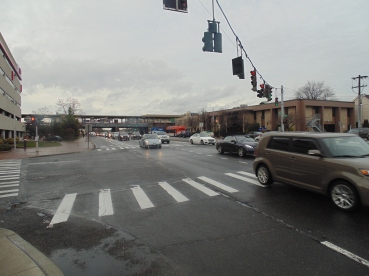
Within a few weeks it was discovered that the old garage was beyond repair. In response the town board voted to borrow $40 million to build a new one. It also approved construction of a temporary parking lot on West John Street and entered into a one-year agreement with Lucky Star Realty to lease an abandoned lot on the corner of West Barclay and Wyckoff Streets. Any overflow from both lots was directed to either the Broadway Mall or the Sears parking lot. These announcements came as a disappointment to many residents who urged the board to consider other options, including building the garage elsewhere or not at all.[78]
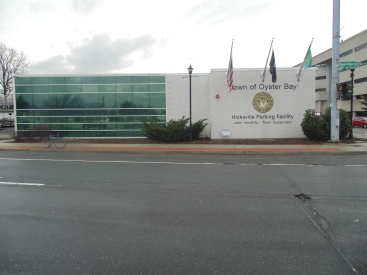
A formal announcement on the design and location of the lot was not made for several months. In the meantime, the piece-by-piece dismantling of the old garage began on September 17, 2008. A demolition bid of $1,573,116 was awarded to the Westbury-based Gramercy Group. Work was twice delayed because of asbestos clean-up concerns. Initial completion was set for November 2008 but was moved to January and finally to March of 2009.[79] During the intervening time, town consultants released their recommendation for the new structure at a town-hosted community meeting on December 3. It proposed rebuilding the garage at the same location. The town agreed and made a formal announcement on January 29, 2009.[80]
Prior to construction, the town received criticism from residents because it was not planning to conduct an environmental impact study at the site. The State Environmental Quality Review Act, which requires government agencies to assess environmental impact, didn’t exist until seven years after the old garage was built. Since the replacement would be rebuilt on the same site, the law stated an environmental study was not required. Town Supervisor John Venditto also added that the town decided not to conduct a formal study because it would delay construction by two years or more.[81]
The new 1,440-vehicle garage opened on March 21, 2011. Total cost, including demolition of the old garage, and temporary parking lots and shuttles, was $65 million. New features included approximately ninety security cameras, energy-efficient LED lighting, and a sensor-operated display board updating the number of available spaces. While the new garage was designed with similar vehicle capacity, it has two levels below grade, one at grade, and one above. The old building had three levels above grade.[82]
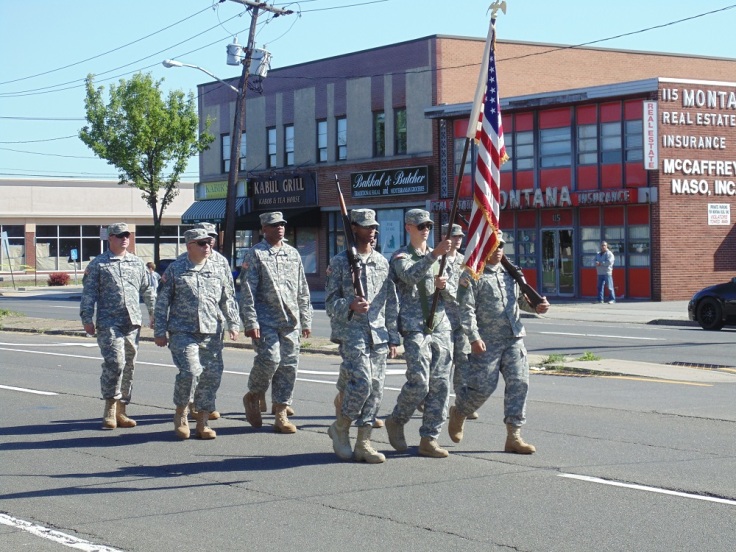
The Future of Hicksville
An anonymous Newsday editorial in 2008 commented that downtown Hicksville was a stubborn symbol of Long Island’s refusal to look to the future.[83] While some beautification and revitalization plans were successful at the turn of the twenty-first century with the help of many community groups and people who participate in civic organizations, to date there is still no downtown to speak of except for the railroad station.
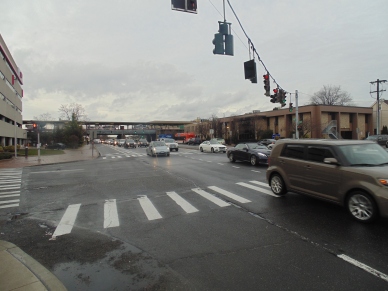
Over four decades after “Hicksville: A Framework for the Future” was published in 1969, downtown stakeholders are still hopeful for the future. Chamber of Commerce President Lionel Chitty said in 2011 that “now’s a great opportunity, if something isn’t done, this area is not going to survive.” While plans in the previous two decades focused on beautification, a new plan addresses the systemic problems from the widening of Broadway. A centerpiece of the new effort is a suggestion to break the existing business district into three zones: a “Main Street” model of retail below apartments and lofts, a residential area with few buildings taller than two stories, and a denser region with housing and offices reaching four levels. Vision Long Island, an organization that helped devise the plan, designed similar projects in more than a dozen communities, including Riverhead and Bay Shore.[84]
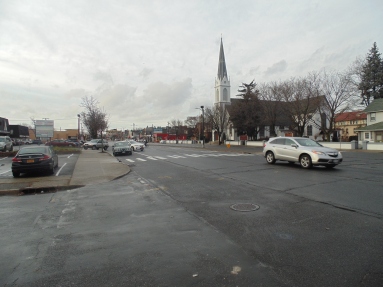
In recent years, the town has committed $3 million to downtown streetscape improvements, such as new sidewalks, decorative lighting, and an athletic center. But, it is not enough. Owing to the railroad nature of the community, Chamber President Chitty commented that “people are coming to Hicksville just to hop on a train and hop off. We’re trying to capture that.” Hopefully soon, work can be done to bring both business to the community and give more of a Main Street-feel. Some stores on Broadway seem miles away from the railroad station and more needs to be done to unite the entire area. While learning from Hicksville’s historic past, community leaders can shape a better future for the Hicksville of tomorrow.[85]

[1] John Rather, “If You’re Thinking of Living In/Hicksville: Snug Houses and Giant Stores in Mid-Nassau,” New York Times, February 13, 2000; Staff of Long Island, Our Story, Home Town Long Island: the History of Every Community on Long Island in Stories and Photographs (Melville, NY: Newsday, 1999), 51.
[2] Ibid; “Long Island Rail Road Alphabetical Station Listing and History,” Trains are Fun, accessed December 13, 2015, http://www.trainsarefun.comlirrphotosLIRR%20Station%20History.htm.
[3] Paul D. Van Wie, The German Settlements of Nineteenth Century Long Island (Long Island, NY: Franklin Square Historical Society, 2003), 47-48.
[4] Staff of Long Island, Our Story, Home Town Long Island, 51.
[5] Van Wie, The German Settlements of Nineteenth Century Long Island, 47-48.)
[6] Ibid., 2.
[7] Ibid., 51-52.
[8] Ibid; Richard and Anne Evers, Hicksville Traumas and a Dilemma: the Elevation of the Railroad, Destruction of West Broadway, and the G-1 Zoning Ordeal, 1961-1986 ([Hicksville, N.Y.]: Historical Committee, Hicksville Gregory Museum, 1988), 74.
[9] A Look back … at Hicksville’s Bravest, photocopied handout presented as part of the “Hicksville Historical Society Meeting: Fire Department History” (Hicksville Public Library, Hicksville, NY: May 29, 2013).
[10] “Courthouse History,” Hicksville Gregory Museum, accessed December 13, 2015, http://www.gregorymuseum.org/courthouse/index.html.
[11] Ibid.
[12] Rather, “If You’re Thinking of Living In/Hicksville.”
[13] “Real Estate Auction at Hicksville,” The Long-Islander (Huntington), May 8, 1925.
[14] Ibid.
[15] “Seaman, Taliaferro & Eisemann, Inc.,” The Long-Islander (Huntington), January 28, 1921; “Stirling Bond & Mortgage Co. of Oyster Bay,” The Long-Islander (Huntington), May 21, 1926; “Chamber of Commerce News,” The Long-Islander (Huntington), June 17, 1932; “Potato Crop of Exceptional Quality Says Chester DeMond,” Patchogue Advance, August 15, 1946; “Town of Oyster Bay Hires Zoning Experts,” Newsday, December 31, 1948; “Hicksville Seeks $10,000 for Memorial,” Newsday, December 18, 1946; “Good Roads Group Names New ‘Driver’,” Newsday, June 29, 1950; “Officials Elected By Nassau’s Banks,” Newsday, January 24, 1952; “His ‘n’ Hers Kitchens Are Separate, Unequal,” Newsday, July 8, 1959 “News Briefs,” Newsday, March 19, 1959; “Holly Patterson, Nassau’s Former Executive to be Feted Jan 25,” The Long-Islander (Huntington), January 11, 1962; “Oyster Bay Board OKs Insurance Plan Study,” Newsday, December 28, 1965.
[16] “Lay Lutheran Church Cornerstone Sun.” Newsday, October 29, 1948; “Law Gives Wife Green Light To Ram. Wreck Hubby’s Car.” Newsday, November 17, 1949; “Ground Broken for Bank Building at Cove,” Newsday, March 27, 1950; “Church Lists Early Mass for Fishermen,” Newsday, April 22, 1952; “LI Business Briefs,” Newsday, April 15, 1958; “His ‘n’ Hers Kitchens Are Separate, Unequal,” Newsday, July 8, 1959; “High Time,” Newsday, November 14, 1960; “Plan $2,500,000 Building Project at S’hampton Coll.,” Long Island Advance (Patchogue), April 29, 1965; “Indict ‘Lonely Heart’ Pair for Murder Here ,” Newsday, March 23, 1949; “Fund to Equal Donations To Welfare Unit,” Newsday, May 12, 1958.
[17] Richard and Anne Evers, Hicksville Traumas and a Dilemma, 29.)
[18] Ibid., 1; Staff of Long Island, Our Story, Home Town Long Island, 51.
[19] Richard and Anne Evers, Hicksville Traumas and a Dilemma, 1-2.
[20] Ibid., 2-3.
[21] Ibid., 10.
[22] Ibid., 4.
[23] Ibid., 11.
[24] Ibid., 22.
[25] Ibid., 11.
[26] Ibid., 7.
[27] Ibid., 24-27.
[28] Ibid., 4.
[29] Ibid., 22-23.
[30] Ibid., 24-27.
[31] Ibid.
[32] Ibid.
[33] Ibid., 35.
[34] Ibid., 29.
[35] Ibid., 33.
[36] Ibid., 38.
[37] Ibid., 42.
[38] Ibid., 38.
[39] Ibid., 29.
[40] Ibid., 64-67.
[41] Ibid., 28.
[42] Ibid., 67.
[43] Ibid.
[44] Ibid., 67-70.
[45] Ibid.
[46] Ibid., 85.
[47] Ibid.
[48] Ibid., 74.
[49] Ibid., 92-94.
[50] Ibid., 85.
[51] Ibid., 61.
[52] Ibid., 92-94.
[53] Ibid., 70-73.
[54] Ibid., 96-101.
[55] Ibid., 113-114.
[56] Ibid., 119.
[57] Ibid., 123.
[58] Ibid., 137.
[59] Paul Schreiber and Sylvia Carter, “LIRR Commuters Given New Power,” Newsday, October 20, 1970.
[60] John Rather, “If You’re Thinking of Living In/Hicksville: Snug Houses and Giant Stores in Mid-Nassau,” New York Times, February 13, 2000.
[61] Richard and Anne Evers, Hicksville Traumas and a Dilemma, 162.
[62] Ibid., 173.
[63] Ibid., 253.
[64] Michael Larkin, “A Part of History: Hicksville’s 350th Anniversary Parade,” Hicksville Illustrated News, September 25, 1998.
[65] Richard Evers, “With Open Arms: 350th Anniversary Church Open House Program,” Hicksville Illustrated News, July 24, 1998.
[66] “Hicksville Fall Festival: October 25,” Hicksville Illustrated News, April 17, 1998.
[67] Michael Larkin, “Many Hands, One Heart: Hicksville, Beautification Movement Strengthens Revitalization Efforts,” Hicksville Illustrated News, October 16, 1998; Michael Larkin, “Project Downtown Study Completed,” Hicksville Illustrated News, April 24, 1998.
[68] Larkin, “Many Hands, One Heart.”
[69] “Gateway to Hicksville,” Hicksville Illustrated News, December 4, 1998.
[70] “Revamping Hicksville’s Kennedy Park,” Hicksville Illustrated News, January 12, 2001.
[71] Charlie Montana, “Hicksville Kiwanis, Chamber Announce Fountain Project,” Hicksville Illustrated News, January 20, 2012.
[72] “New Community Signs Highlight Hicksville’s Roots,” Hicksville Illustrated News, August 17, 2001.
[73] Michael Larkin, “Gregory Museum Restoration Continues,” Hicksville Illustrated News, April 17, 1998.
[74] Michael Larkin, “A New Piece of History,” Hicksville Illustrated News, June 25, 1999.
[75] Michael Larkin, “Fire at the Gregory,” Hicksville Illustrated News, July 9, 1999.
[76] “Hicksville Gregory Museum: Reopening July 24,” Hicksville Illustrated News, July 23, 1999.
[77] Steve Ritea, “Hicksville LIRR Lot Shut Structural Crack Found in Four-Level Garage Near Railroad Station,” Newsday, June 4, 2008; Susana Enriquez, “Crumbling Garage Costs Town Oyster Bay Pays Out $21,000 to Commuters Whose Vehicles Have Been Damaged in Aging Parking Structure near Hicksville LIRR Station,” Newsday, September 10, 2008; Susana Enriquez, “Garage Already Due for Repairs Work Scheduled at Parking Structure at Hicksville LIRR Station Didn’t Include Cracks Discovered This Week,” Newsday, June 4, 2008.
[78] Susana Enriquez, “Oyster Bay to Borrow $40M for Garage,” Newsday, July 16, 2008; Susana Enriquez, “Hicksville: Work to Begin on Garage,” Newsday, September 17, 2008.
[79] Susana Enriquez, “Hicksville: Work to Begin on Garage,” Newsday, September 17, 2008; Susana Enriquez, “Hicksville Garage Delay Demolition Slowed by Work-Time Restrictions and Asbestos until Mid-January,” Newsday, October 24, 2008; Susana Enriquez, “Hicksville: Demolition delayed,” Newsday, January 22, 2009.
[80] Susana Enriquez, “Hicksville: Study Build Garage at Old Site Consultants say Best Bet is to Put New Hicksville Parking Area where Current One is Being Torn Down,” Newsday, December 5, 2008; Susana Enriquez, “Hicksville: Garage Will Be Rebuilt at Same Site, Town Says,” Newsday, January 30, 2009.
[81] Susana Enriquez, “Oyster Bay: More Ire Over Garage, Residents are Upset Town Will Not Assess Environmental Impact of the New Hicksville Parking Structure,” Newsday, October 24, 2008.
[82] Paul LaRocca, “Oyster Bay: New Hicksville LIRR Parking Garage Open,” Newsday, March 22, 2011.
[83] Anonymous, “Hicksville on the Brink: Replacement of that Crumbling Parking Garage Offers an Opportunity to do Something Grand at this Important Nassau Hub,” Newsday, September 14, 2008.
[84] Paul La Rocca, “In Hicksville, New Visions for Downtown,” Newsday, May 23, 2011.
[85] Ibid.